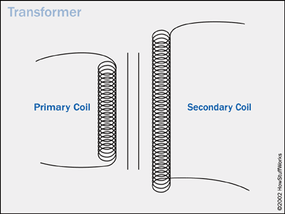The Boost
In the last section, we saw that a flash circuit needs to turn a battery's low voltage into a high voltage in order to light up a xenon tube. There are dozens of ways to arrange this sort of step-up circuit, but most configurations contain the same basic elements. All of these components are explained in other HowStuffWorks articles:
- Capacitors - Devices that store energy by collecting charge on plates (see How Capacitors Work)
- Inductors - Coiled lengths of wire that store up energy by generating magnetic fields (see How Inductors Work)
- Diodes - Semiconductor devices that let current flow freely in only one direction (see How Semiconductors Work)
- Transistors - Semiconductor devices that can act as electrically controlled switches or amplifiers (see How Amplifiers Work)
The diagram below shows how all of these elements come together in a basic flash circuit.
Advertisement
Taken in its entirety, this diagram may seem a little overwhelming, but if we break it down into its component parts, it isn't that complicated.
Let's start with the heart of the circuit, the main transformer, the device that actually boosts the voltage. The transformer consists of two inductors in close proximity to each other (for example, one might be wound around the other, with both might be wound around an iron core).

If you've read How Electromagnets Work, you know that passing current through a coiled length of wire will generate a magnetic field. If you've read How Inductors Work, you know that a fluctuating magnetic field, generated by fluctuating electric current, will cause a voltage change in a conductor. The basic idea of a transformer is to run current through one inductor (the primary coil) to magnetize another conductor (the secondary coil), causing a change in voltage in the second coil.
If you vary the size of the two inductors -- the number of loops in each coil -- you can boost (or reduce) voltage from the primary to the secondary. In a step-up transformer like the one in the flash circuit, the secondary coil has many more loops than the primary coil. As a result, the magnetic field and (by extension) voltage are greater in the secondary coil than in the primary coil. The trade-off is that the secondary coil has weaker current than the primary coil. (Check out this site for more information.)
To boost voltage in this way, you need a fluctuating current, like the AC current (alternating current) in your house. But a battery puts out constant DC current (direct current), which does not fluctuate. The inductor's magnetic field only changes when DC current initially passes through it. In the next section, we'll find out how the flash circuit handles this problem.
